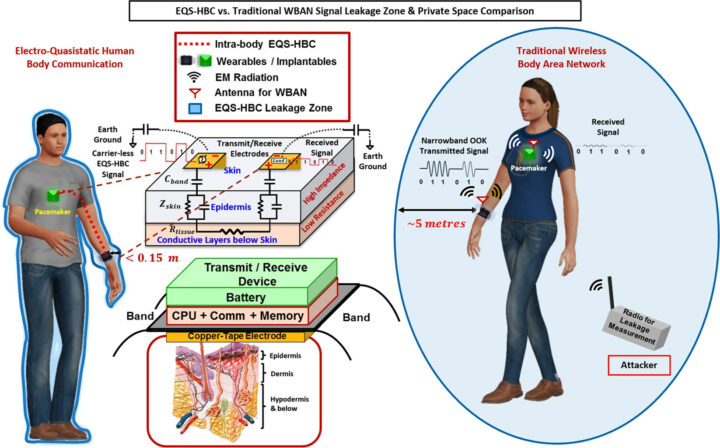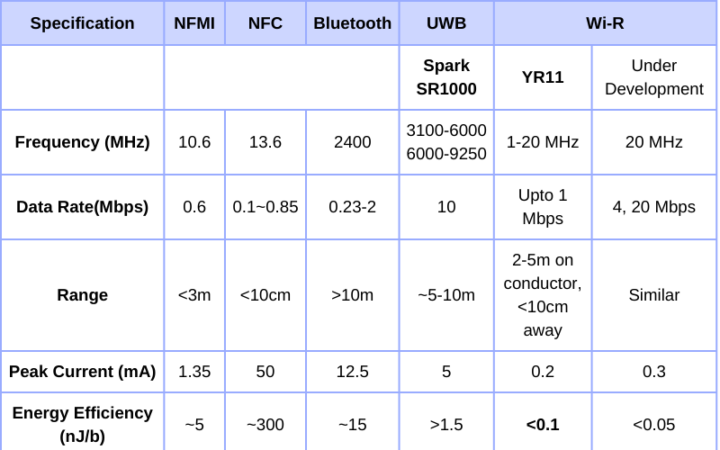The Wi-R protocol is a non-radiative near-field communication technology that uses Electro-Quasistatic (EQS) fields for communication enabling the body to be used as a conductor and that consumes up to 100x less energy per bit compared to Bluetooth.
In a sense, Wi-R combines wireless and wired communication. Wi-R itself only has a wireless range of 5 to 10cm, but since it also uses the body to which the Wi-R device is attached, the range on the conductor is up to 5 meters. While traditional wireless solutions like Bluetooth create a 5 to 10-meter field around a person, the Wi-R protocol creates a body area network (BAN) that could be used to connect a smartphone to a pacemaker, smartwatch, and/or headphones with higher security/privacy and longer battery life.

One of the first Wi-R chips is Ixana YR11 with up to 1Mbps data rate, and they are working on a YR21 IC supporting up to 20 Mbps.
Ixana YR11 key features:
- Frequency – 1 to 20 MHz
- Data rate – Up to 1 Mbps
- Range – 2 to 5 meters on conductor, <10cm away
- Peak current – 0.2 mA
- Energy efficiency – < 0.1 nJ/bit
We can see a comparison between Wi-R and NFC, NFMI (Near-Field Magnetic Induction), Bluetooth, and UWB in the table below provided by Axana.
In their white paper, the company goes through some of the use cases, benefits, and capabilities of Wi-R:
- Communicate with Touch: Combine touch, intent, and communication in a single action
- Pairing-free smart devices. The device can be used as soon as it is in contact with the body
- Touch Selectivity: Transfer contacts with a fist bump
- Multiple time-synchronized wearables: multiple body motion trackers can easily be supported
- Ultra-low energy consumption: all-day, real-time, distributed AI
- High-speed (for future chips like the YR21): Stream video from AR headset to smartphone
- Physically secure due to the way the technology work plus an additional layer of security for sensitive data or action
- Negligible Inter-Human Interference: Increases capacity of communication in a space with multiple humans with each having multiple wearables
- Charging-free patches. Wi-R opens the door for long-lasting and even charging-free patches for many low-speed applications by lowering the communication energy by up to 100 times
- Distributed computing in BAN: augmenting humans with real-time AI
It looks like it could even be fun for parties provided it works as demonstrated in the video below…
An obvious drawback compared to Bluetooth is that it must be in contact with your body or it’s not going to work. You can’t simply leave your smartphone on your desk or bed table and listen to music or audiobooks. Wi-R does not appear to be standardized, or at least not yet, and it will have to the integrated into smartphones to gain adaption, but with low adoption, manufacturers will not be interested in adding the protocol to their devices. It might be possible to add Wi-R through a smartphone cover which could help.
The company is already taking orders for the YR11 chip (100K MOQ) or a Wi-R Audio/Video communication module based on YR11 (10K MOQ), and if your company has plans to design or manufacture Wi-R devices you should be able to acquire evaluation kits either comprised for a board, a headphone kit, or an AR video camera kit for $899 to $2,299.99 depending on the items in the kit. Wi-R connectivity is added to the smartphone through a USB-C plugin, and an Android SDK is provided in each kit.
Additional information may be found on the Ixana website.

Jean-Luc started CNX Software in 2010 as a part-time endeavor, before quitting his job as a software engineering manager, and starting to write daily news, and reviews full time later in 2011.
Support CNX Software! Donate via cryptocurrencies, become a Patron on Patreon, or purchase goods on Amazon or Aliexpress








It’s a little too early for this, don’t you think?
A Standard for the Transmission of IP Datagrams on Avian Carriers
https://datatracker.ietf.org/doc/html/rfc1149
It’s not so new. Microchip has something similar for many years. They call it BodyCom:
http://ww1.microchip.com/downloads/en/AppNotes/00001391C.pdf
That is correct. People have been trying to achieve this for the last 3 decades.
However, to our knowledge, no one has even come close to demonstrating 1Mbps data transfer reliably between two wearables.
Studies on long term health effects?
Small scale clinical study: https://ieeexplore.ieee.org/document/9064912
Wi-R confines the signal in a bubble around the surface. Signal does not penetrate inside the body.
On the contrary, you are being bombarded 24*7 by 4G/5G and other wireless signals.
The first thing that came to my mind is putting your car remote against your head to increase range…
Impressively low power at up to 20 mB/s? Mbps? We might see how the first batch of chips do. Really calls for some extra work to share auth tokens with it over just YubiKey methods. Sure LG, have it on mobile hardware.
The batch of chips battle-tested are already at 1Mbit/s. 4Mbit/s chips are shipping to partners. We are nowhere close to the limits of Wi-R data rates, 20Mbit/s is just what are testing.
We have already shared auth tokens (using FIDO2). One of our partners is using Wi-R for this application.
Thank you for covering Wi-R.
Quick note: “An obvious drawback compared to Bluetooth is that it must be in contact with your body or it’s not going to work. You can’t simply leave your smartphone on your desk or bed table and listen to music or audiobooks.”
We haven’t talked much about it, but Wi-R does work at a distance. At this point, we design it to work few inches from a surface or skin. At Mobile World Congress (MWC2023), those visiting our booth will be able to experience a demo of music streaming from a platform on the floor to a headphone on the head. The streaming works even if someone is wearing a shoe, as well as when you lift the shoe ~6 inches off the platform.